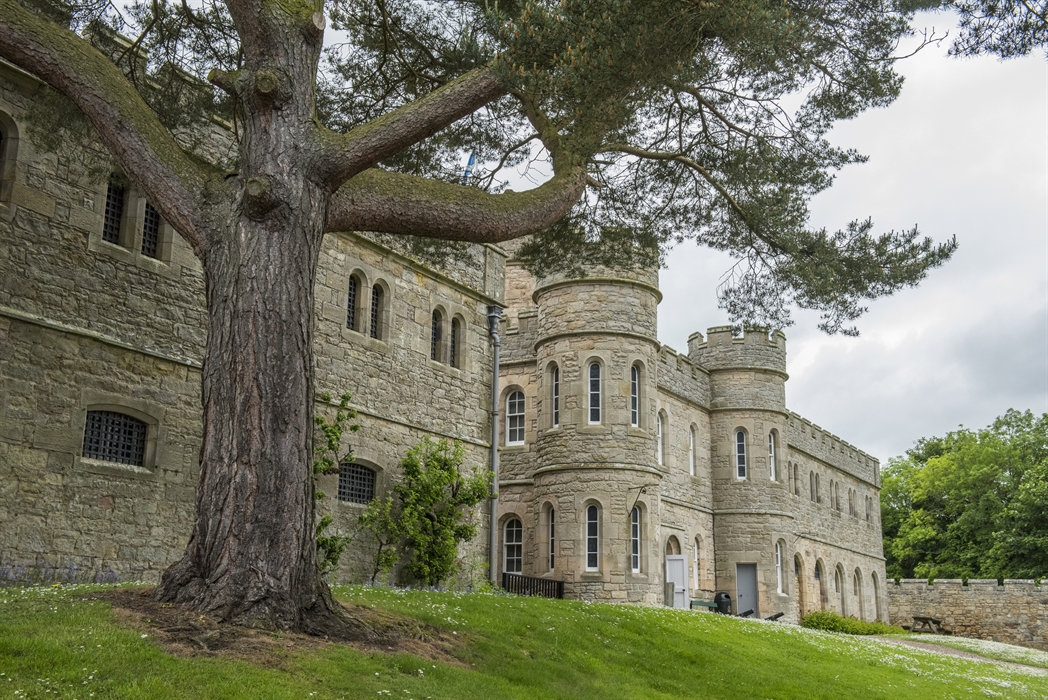Jedburgh Castle Jail & Museum is a fascinating historical site located in Jedburgh, a town in the Scottish Borders. This former 19th-century jail has been converted into a museum that offers visitors a glimpse into the past, exploring the history of crime and punishment in Scotland as well as the broader historical context of the region. The museum is a significant cultural and educational resource, providing insights into the penal practices of the 1800s and the architectural evolution of prisons.
Historical Background
Jedburgh Castle: Originally, a medieval castle stood on the site where the jail now resides. The castle, constructed by David I of Scotland in the 12th century, was strategically important but was destroyed in 1409 by the Scots to prevent it from falling into English hands during the Wars of Scottish Independence.
The Jail: In 1823, on the site of the former castle, a new jail was built, designed by the famous Scottish architect Archibald Elliot. It was constructed as a Howard Reform prison, named after the prison reformer John Howard, and was intended to improve the conditions and treatment of prisoners. The jail was operational until 1868, after which it served various other purposes before being preserved as a museum.
Architecture
The jail is an excellent example of early 19th-century prison architecture. Designed with reformist ideals in mind, the structure was meant to provide better living conditions for inmates compared to earlier prisons.
Design Features:
- Cell Layout: The prison cells were designed to be more humane, with better ventilation and lighting than previous jails. Each cell had a window, a significant improvement over the dark, overcrowded conditions typical of earlier facilities.
- Central Courtyard: The jail featured a central courtyard, which provided outdoor space for prisoners. This design was intended to allow for exercise and reduce the health problems associated with confinement.
- Security Measures: Despite the reformist intentions, the jail was equipped with robust security features to prevent escapes and maintain order.
The Museum
Today, Jedburgh Castle Jail & Museum provides a detailed look at the history of the site and the broader themes of criminal justice, social history, and architectural development.
Exhibits:
- Prison Life: The museum’s exhibits focus on the daily lives of prisoners, showcasing their routines, punishments, and rehabilitation efforts. Visitors can see reconstructed cells, complete with period furnishings, giving an authentic sense of 19th-century prison conditions.
- Historical Artifacts: The museum houses various artifacts from the jail’s operational period, including uniforms, tools, and personal items belonging to inmates and staff.
- Interactive Displays: Interactive exhibits and multimedia presentations provide engaging ways to learn about the history of crime and punishment, as well as the architectural and social reforms that influenced the design of the jail.
Educational Programs: The museum offers educational programs for schools and groups, focusing on different aspects of social history and the evolution of the penal system. These programs are designed to enhance the educational experience through hands-on learning and interactive activities.
Special Events: Throughout the year, the museum hosts special events and exhibitions, often featuring reenactments, historical talks, and themed tours. These events provide deeper insights into specific aspects of the jail’s history and the broader context of 19th-century Scotland.
The Significance of Jedburgh Castle Jail & Museum
Jedburgh Castle Jail & Museum is not just a preserved historical site but also a vital educational resource. It serves multiple purposes:
- Preservation of History: The museum preserves and interprets an important part of Scotland’s social and architectural history, offering a window into the past.
- Education: Through its exhibits and programs, the museum educates the public about the history of criminal justice, prison reform, and the daily lives of those who lived and worked in the jail.
- Cultural Heritage: The site contributes to the cultural heritage of Jedburgh and the Scottish Borders, attracting tourists and researchers interested in Scotland’s history.
Visiting Jedburgh Castle Jail & Museum
Location: The museum is located in Jedburgh, easily accessible by car and public transport. The address is Castlegate, Jedburgh, TD8 6QD, Scotland.
Opening Hours: The museum is typically open year-round, with seasonal variations in opening hours. It is advisable to check the museum’s official website or contact them directly for the most up-to-date information.
Admission: There is usually an admission fee, with discounts available for children, seniors, and groups. Special events and educational programs may have separate pricing.
Facilities: The museum offers various visitor amenities, including guided tours, a gift shop, and educational resources. Accessibility options are available to accommodate visitors with disabilities.
Conclusion
Jedburgh Castle Jail & Museum is a unique and engaging historical site that offers valuable insights into the evolution of the penal system and 19th-century social history in Scotland. Its preservation and interpretation of the past make it an important cultural and educational resource for visitors of all ages. Whether you are a history enthusiast, a student, or simply curious about the past, a visit to Jedburgh Castle Jail & Museum promises a rich and informative experience.



